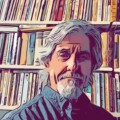A Visit with DAI Curator Annie Dugan

Since its incorporation in 1907, the Duluth Art Institute has become the Northland’s premier center for the exhibition, study, and production of visual arts, achieving its mission and goals through three primary services for artists and the community at large: the Exhibition Program, the Education Program, and Artist Services. The current curator is Annie Dugan. I’ve been impressed with her energy and enthusiasm and believe she’s been a real asset in our fermenting local arts scene.
EN: It seems like the local arts scene has become quite vibrant this past couple years. Why is that?
Anne Dugan: Whatever is contributing to the magical mix, it’s exciting! It does seem that people are choosing to stay in Duluth and Superior and create and show art here. It’s the passion and dedication of individuals who are making this happen. People painting walls in new spaces after they work a day job, people creating art after they put their kids to bed, people writing about art and talking about art—it takes a critical mass of inspired individuals.
There seems to be more of a melding of the various arts practices as well: music, theater, and visual arts are starting to work together rather than fighting against each other for resources. We’ve seen new spaces open up for the exhibition of visual arts. There were over 20 stops on the last two Twin Ports gallery progressives, and that didn’t necessarily include every potential space.
I think people are also feeling appreciated for their choices to create and exhibit art. Superior has seen tremendous things happen because of the support from the mayor, from the chamber, and from institutions that have previously been afraid or resistant to the idea of art and artists.
One possible silver lining to come out of the recession is that people turned to doing things themselves—making art, enjoying art. These are important ways of engaging with the world that can be a lot more meaningful than passive consumerism.
EN: Briefly, how did you come to be curator at Duluth Art Institute and what does a curator do?
AD: I was lucky enough to take the job as curator at the Duluth Art Institute two years ago. My training is in art history and curatorial studies, and I was incredibly lucky to find a job that fit my education so well. I had worked with the Duluth Art Institute before, so I was familiar with the institution and staff, but I still feel amazingly fortunate to have landed my “dream job.”
The term curator covers a lot of ground these days—people use the term for all sorts of things. Basically a curator is someone who organizes and presents cool things to the public. At the Duluth Art Institute, the curator is the person that selects exhibits and interprets the works on view. Because we have an extremely small staff, the curator at the Duluth Art Institute also functions as the preparator, registrar, grant writer, program coordinator, party planner, marketer, etc.
EN: Why, in your opinion, is it important for art to connect with the public? That is, why are the arts important for communities like ours?
AD: I would say it is vital that the arts connects with the public. Is it really art if it doesn’t? The arts can raise questions, compel us to think about problems in different ways, and help us be more tolerant. The arts can inspire us and give meaning to our lives. The arts can be a way to come together and provide joy. I’m sounding a lot like an inspirational poster, so I’ll stop, but the arts can play a practical role in our community as well. Arts can drive business and attract a smart, talented work force.
EN: How did you become interested in a career in the arts?
AD: I actually started out in college as a geology major but I had always loved art history. My family was pretty nerdy so we would go to museums for vacations. I ended up realizing that what I loved about geology was looking closely at something to find clues to its past. What I didn’t love was higher math, so I ended up switching to art history. I was fortunate enough to work at the Walker Art Center after college, which gave me a pretty great introduction to the possibilities of a career in the arts.
EN: Do you paint or draw? Where can we see some of your work?
AD: I express myself creatively through my curatorial practice. I do some drawings for relaxation and I also garden in the summertime. Come over to my place in late August for a beet vodka cocktail next to my sunflowers and we can talk art—that would be the best place to see my “work”!
